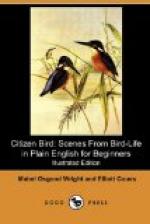“Tell us the names of some Invertebrates, please, Doctor,” said Rap.
“Well, all sorts of insects are Invertebrates, and so are lobsters and crabs, oysters and clams, worms, starfishes, jelly-fishes, corals, and even sponges. Then there are some too small to see without a microscope. But never mind about Invertebrates now. I only want you to remember that all beasts, birds, reptiles, and fishes are Vertebrates, and that there are five principal classes of them. If I should tell you as much about them as I have about the Building of a Bird, you would see that they are all built on what we call the Vertebrate plan of structure. Here is a chart of the Classes of Vertebrates—you can study it this afternoon, till you learn it by heart.”
VERTEBRATES
Animals with Backbones
CLASS I. Mammals.—Warm-blooded animals which have fur or hair, bring forth their young alive, and nurse them. House People are Mammals.
CLASS II. Birds.—Warm-blooded animals which have feathers and lay eggs.
CLASS III. Reptiles.—Cold-blooded animals which have scaly skins, like lizards, snakes, and turtles.
CLASS IV. Batrachians.—Cold-blooded animals which have naked skins, like frogs, toads, and newts.
All the foregoing classes, except a few of the Batrachians, breathe air in lungs, and almost all, except snakes, have legs; none now living can fly, except bats and birds; but bats are Mammals.
CLASS V. Fishes.—Cold-blooded animals which have either scaly or naked skins, but no fur or feathers; which live in the water, breathe it with their gills, and swim in it with fins.
CHAPTER V
CITIZEN BIRD
The apple trees were in full bloom the day that the Doctor again found time to be with the children. It was exactly the kind of a day that birds like. The ground was soft enough to let the earthworms come up to breathe, so that Robins could catch them easily, and the air was full of all kinds of insects newly out from their long winter sleep in their soft cocoon beds, much to the delight of the Swallows and Flycatchers.
It was also a beautiful day for House People to watch their bird neighbors; for it was mild but not too bright, and every one knows how it hurts the eyes to look at flying birds with the sun shining in them.
Olive, Dodo, and Nat went out first and found Rap waiting. The Doctor followed, carrying something in his hand in a black leather case. When they arrived at the old tree in the orchard, he told them to look up. There was the perch arranged as it had been when he was a boy. Not a perch for birds, but for House People—narrow board seats fitted in between the largest branches and a bar fastened across some of the highest ones, so that it was quite safe to climb up and look out of the top of the tree.




